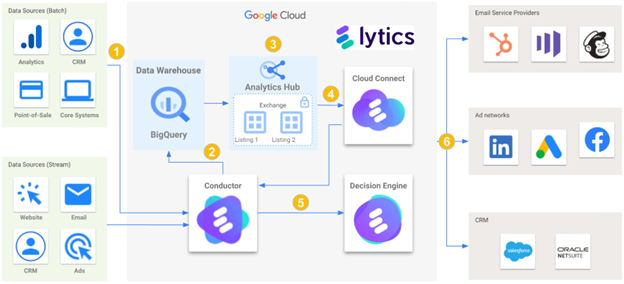Lytics + Built with BigQuery: Unlocking the data sharing and enrichment potential of your cloud data warehouse
June 5, 2023To fully unlock the transformative potential of customer data, data warehouses must represent a key component in a business’ customer data architecture. A cloud-based data warehouse, Google BigQuery in particular, should be the flexible, robust, and dynamic source of truth for the data that drives your business.
If your organization has machine learning-infused, business intelligence-based, digital transformation ambitions, you’ll need a powerful, scalable, cloud-based warehousing solution to reach them. For thousands of brands worldwide, that solution is Google BigQuery.
Newly announced at the 2022 Data Cloud Summit a few months ago, Google Cloud’s Built with BigQuery initiative helps independent software vendors (ISVs) “get started building applications using data and machine learning products to help them accelerate, optimize, and amplify their success.” When paired with Lytics Conductor, Built with BigQuery helps businesses ingest, store, analyze, visualize, and activate data with ease, and providing much-needed access to dedicated engineering teams, and to marketing teams for co-marketing and go-to-market support.
But before we dive into the synergistic capabilities of both solutions, let’s go back to basics, and start at the beginning.
What is Google BigQuery?
Google BigQuery is a powerful data warehouse solution, available in the Google Cloud Platform, that —for data managers, engineers, and analysts— means you can analyze terabytes of data in a matter of seconds. BigQuery combines the power of a cloud-based data warehouse with robust analytics tools, and its serverless infrastructure lets your teams focus on making the most of your data, rather than worrying about resource management.

Google Cloud highlights it as the “cost-effective, serverless, multi-cloud enterprise data warehouse solution” built to power your data-driven innovation and empower your teams to hone insights from your data, fast. Plus:
- Run analytics at scale
- Democratize insights with built-in business intelligence and machine learning capabilities
- And inform smarter business decisions from data across clouds with a single, flexible, solution.
But if BigQuery is at the core of the solution, what exactly is the problem? Here are the data management issues modern enterprises are contending with.
The need for better data management in the age of data overload
Businesses today are collecting data at a unprecedented pace, and it’s catalyzed a need for tools that support data management, storage, and business decisioning that’s powered by big data and analytics.
The brands in need —data-driven hopefuls that they are— want to be able to do so flexibly, securely, with ease, and at scale. But it’s not always that simple.
If you asked today’s CMOs, 67% would tell you that they’re overwhelmed by the sheer volume of data at their disposal. Yet despite this data overload problem, 56% of IT leaders feel responsible for providing marketing teams with data modeling and access to the right data to power their operations — in addition to the data management requirements that come with their own set of KPIs and success metrics.
Google says: “As enterprises look to [deal] with growing data volumes, they face tremendous challenges as their costs continue to spiral out of control. Traditional data warehouses were not designed to handle the explosive growth in data, and certainly not built for emerging data processing patterns.”
To make matters even more complex, there’s still a gap between data managers and marketing managers — and Lytics’ own research shows that only about 26% of IT and marketing professionals feel their cross-functional collaboration is strong.
Meanwhile, a rapidly changing landscape continues to increase need for data sharing mechanisms with:
- Improved security,
- Improved control,
- Future-proof architecture,
- Marketing activation capabilities,
- Enterprise-level scalability,
- And the ability to keep brands resilient in the face of third-party cookie changes and evolving data privacy regulations.
So, how do you work around these challenges? You take your data warehouse, and pair it with tools that multiply its value.
The rising importance of data sharing and clean rooms
With ever-changing and increasingly strict regulations regarding data privacy, organizations that need to share data with business partners need to be able to do so in a way that avoids duplicating and moving data, and that allows for only certain data elements to be shared. In clean rooms, partners can:
- Match lists
- Share contacts
- Augment profiles
- Run joint campaigns
- And share and activate data across an enterprise, while protecting PII.
More and more organizations have identified the benefits of securely sharing and organizing customer data as a means to improve business performance. Critical in the use case is the need to suppress PII during the process of enrichment while fully enabling data dependent teams, while avoiding the risk of exposing any sensitive data.
Lytics and Google have been developing a scalable and repeatable offering for securely sharing data which utilizes the Analytics Hub that sits atop Google Cloud (BigQuery) and the Lytics Platform. BigQuery’s capabilities have enabled use cases from data aggregation, data analysis, data visualization, and activation, all of which are able to be executed with extremely low-latency.
So, why Lytics + Built with BigQuery?
Over the past decade, Lytics has been responsible for making customer data the driving force behind the next generation of customer-centric brands. Offering key infrastructure to connect disparate data, build unified profiles, surface customer insights, and activate high-value data. Lytics CDP works in real-time, so your teams never miss a beat — or an opportunity to meaningfully engage with a customer.
Leading identity resolution and insight capabilities give you the ability to resolve merge conflicts, so you can leverage our hundreds of connections with downstream marketing tools to reach the right customer, with the right message, at the right time — and on their channel of choice.
Pairing the powerful Lytics platform with Built with BigQuery, customers gain:
- Highly scalable, controlled access to mission-critical data with ability to easily activate.
- Fast return on investment (ROI) for both Lytics and Google services and infrastructure.
- A future-proof solution to facilitate any need or challenge their industry faces as privacy constraints tighten.
Here’s why it works.
Lytics + Built with BigQuery: What you stand to gain
Imagine your company is a parent brand that wants to aggregate behaviors across all of their child brands, and surface aggregated insights to improve their child brands’ ability to cross-sell — all without replicating data or exposing personally identifiable information (PII) unnecessarily. Imagine that you want to collaborate with another brand by sharing data to be used to identify customers who are highly likely to be interested in a joint offering. Or to suppress consumers with a particular behavior in order to maximize returns. Or to share a subset of data, but only for a short period of time.
Lytics, paired with Built with BigQuery, makes it, not just possible, but easy.
Have we piqued your curiosity? Here are 7 key considerations to keep in mind:
- Built on top of GCP, Built with BigQuery is laser-focused on building, enriching and activating BigQuery-based warehouses.
- It provides a scalable and repeatable path for securely sharing data for enrichment, suppression, etc.
- It enables data dependent teams (BI, Data Science, etc.), without risking exposure of unnecessary data points or PII.
- Once you’ve built your BigQuery warehouse, Lytics provides access for activation from your BigQuery warehouse.
- You must go in with a clear identity matching solution such as hashed identifiers or additional third parties, such as RampID in both the source listing as well as consumer’s data set.
- Many marketing use cases rely on real-time decisions and working with a data warehouse and exchanges will introduce some amount of latency in the workflow.
- It requires an initial investment for set up, but that pays off in the long run.
Now that we’ve addressed why it works, let’s explore how it works.
Lytics + Built with BigQuery: How it works
Ready to make the most of your cloud data warehouse investment? To gain insights with real-time and predictive analytics? To protect your data and operate with trust? To break down your data silos and prevent lock-in, guaranteeing the choice to work with data across any platform or environment? To activate the treasure trove of data at your fingertips?
Leverage Lytics Conductor to build or expand your existing BigQuery warehouse with event and profile syncs, including using Google’s Analytics Hub to create master data exchanges, and any number of listings, focused on secure, controlled consumption of critical datasets for your partners or your child brands.
To help make things clearer, here’s a visual breakdown of how Google and Lytics work together to securely access to your data warehouse(s), manage identities, and leverage decisioning capabilities using:

- BigQuery
- Analytics Hub
- Google Cloud (GCP)
Lytics
It’s important to note that once you’ve used Conductor to aggregate disparate data sources, you can build profiles using industry leading identity resolution capabilities, then enrich your profiles, and fully activate across all marketing channels seamlessly.
What’s next for Lytics and Google?
This year, Lytics is leveraging BigQuery to launch its clean room solution, a secure data sharing and enrichment offering from Lytics, running on Google Cloud, for advertisers and media brands. The integration with BigQuery makes Lytics an ideal application to simplify and unlock data sharing by unifying and coalescing datasets that help businesses to build or expand existing BigQuery data warehouses.
“With Google Analytics Hub, Lytics is able to provide capabilities that improve data management needs on behalf of organizations focusing on getting maximum value out of data,” says Jascha Kaykas-Wolff, President, Lytics. “Lytics Clean Room solution can decrease the time to value in complex data sharing scenarios where partnership collaboration is safe and secure and cross-brand activation can be done in hours.”
With Lytics Clean Room solution customers can securely share data hosted on Google Cloud’s BigQuery and unify first-party datasets into customer profiles. The highly scalable and secure solution provides tighter control of mission critical data for faster activation. It can also be leveraged to comply with stringent privacy constraints, industry compliance standards and newer regulations.
Ready to take the leap?
As we addressed in an earlier blog post, your data warehouse —75% of which will be cloud-based by 2023, according to Gartner’s estimates— allows you to consolidate all of your disparate data sources into one secure, centralized location for better organization and easier access.
Lytics helps you maximize the value of that warehouse investment. And in addition to our Google Marketplace integrations and Private Instance and Private Cloud deployments on Google Cloud, pairing Lytics with Built with BigQuery is just another way Lytics and Google are partnering to keep customers ahead of the curve.
It’s the next step, among many, in providing the absolute best experience for our customers that the power of customer data can offer.
Learn more from the Google Cloud blog.
This article was originally published on Lytics website. Click here to see the original blog post.


